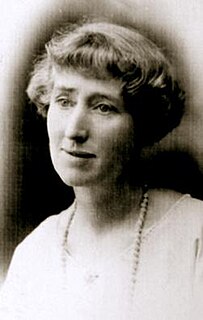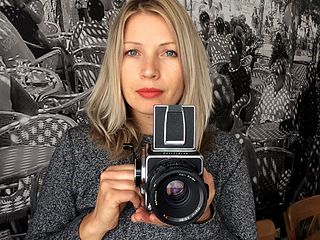
Joan à Beckett Lindsay, also known as Lady Lindsay, was an Australian novelist, playwright, essayist, and visual artist. Trained in her youth as a painter, Lindsay published her first literary work in 1936 at age forty under a pseudonym, a satirical novel titled Through Darkest Pondelayo. Her second novel, Time Without Clocks, was published nearly thirty years later, and was a semi-autobiographical account of the early years of her marriage to artist Daryl Lindsay.
Surreal humour is a form of humour predicated on deliberate violations of causal reasoning, producing events and behaviours that are obviously illogical. Constructions of surreal humour tend to involve bizarre juxtapositions, incongruity, non-sequiturs, irrational or absurd situations and expressions of nonsense.

Thomas Bock was an English-Australian artist and an early adopter of photography in Australia. Born in England he was sentenced to transportation in 1823. After gaining his freedom he set himself up as one of Australia's first professional artists and became well known for his portraits of colonists. As early as 1843 he began taking daguerreotypes in Hobart and became one of the earliest commercial photographers in Australia.

Damascus College is Ballarat’s only Catholic co-educational secondary college. It was established after three separate Catholic colleges, St Martin's in the Pines, Sacred Heart College and St Paul's College amalgamated. The college is located on a treed 20 hectare campus in Mount Clear, 7 km from Ballarat's central business district. Damascus College is a day school for secondary students in years 7 to 12.
Bob Jenyns is a prolific Australian artist whose practice, spanning over four decades, has produced countless sculptures, prints, drawings, and paintings. He has participated in many of Australia's most significant art exhibitions including the first Biennale of Sydney (1973), the 1973, 1975 and 1978 Mildura Sculpture Triennials, the 1981 Australian Perspecta, the 2nd Australian Sculpture Biennale, and the 1990 Sculpture Triennial. Jenyns was a finalist in the 2006 Helen Lempriere National Sculpture Award, and in 2007 won the award with his work Pont de l'archeveche. He is represented in many of the country's largest collections, including the National Gallery of Australia, the Art Gallery of New South Wales, the Queensland Art Gallery, the Museum of Contemporary Art in Brisbane, and the Tasmanian Museum and Art Gallery. Jenyns has also received multiple grants from the Australia Council's Visual Arts Board, has curated exhibitions and has taught at the Tasmanian School of Art as head of the sculpture department (1982–2005).

Comedy is a genre of fiction consisting of discourses or works intended to be humorous or amusing by inducing laughter, especially in theatre, film, stand-up comedy, television, radio, books, or any other entertainment medium. The term originated in Ancient Greece: in Athenian democracy, the public opinion of voters was influenced by political satire performed by comic poets in theaters. The theatrical genre of Greek comedy can be described as a dramatic performance pitting two groups, ages, genders, or societies against each other in an amusing agon or conflict. Northrop Frye depicted these two opposing sides as a "Society of Youth" and a "Society of the Old." A revised view characterizes the essential agon of comedy as a struggle between a relatively powerless youth and the societal conventions posing obstacles to his hopes. In this struggle, the youth then becomes constrained by his lack of social authority, and is left with little choice but to resort to ruses which engender dramatic irony, which provokes laughter.
John Kelly is an Australian artist.
Terry Batt is an Australian artist and sculptor.
Matthew James Thomas, known professionally as Matt Doll, is an Australian musician, singer-songwriter and producer. He was the lead vocalist, rhythm guitarist and songwriter of the rock band, the Mavis's. He formed the group with his younger sister, Rebecca Thomas, on vocals and keyboards in 1987. They released three studio albums, Venus Returning, Pink Pills and Rapture ; however, they had already disbanded in December 2001. Subsequently, they have reformed in 2013, 2014 and 2018.

The Royce Twins are Australian based singer-songwriters from Mount Beauty, Victoria, Australia and now called Melbourne home. The duo consists of twin brothers Gabriel Saalfield and Michael Saalfield. The Twins have been singing and playing music together as long as they can remember.

John Chester Cato was an Australian photographer and teacher. Cato started his career as a commercial photographer and later moved towards fine art photography and education. Cato spent most of his life in Melbourne, Australia.

Euphemia Eleanor Baker (1880–1968) was an Australian photographer, and follower and advocate of Baháʼí Faith. Initially she took pictures of Australian wildflowers and published them in a booklet form. Later, after becoming a follower of Baháʼí Faith in 1922, she took pictures of the Baháʼí monuments in Australia, New Zealand, Iraq and Persia, some of which were included in Shoghi Effendi's translation of the book The Dawn-Breakers. She became one of the Baháʼí Faith's notable photographers.
Elaine Alys Haxton, AM was an Australian painter, printmaker, designer and commercial artist.

Maude Edith Victoria Glover Fleay (1869–1965), was one of Australia's first wildlife artists. She was known for her paintings of Australian marsupials.

Aldona Kmieć is an Australian contemporary artist working in Photography and Installation Art. Her works are held in public collection of State Library of Victoria, Museum of Democracy at Eureka in Ballarat, Ballarat Arts Foundation and private collections.

Percival Albert Trompf (1902-1964), was an Australian commercial artist, best known for his travel posters, books, advertising hoardings and pamphlets promoting the nation's tourist industry and Australian and international corporations and companies. His colour lithography was recognised as distinctive during his career and since, Art Deco in style, and innovative in its use of flat colour. Some of his designs depicted historical events, including the construction of the Sydney Harbour Bridge and Captain Cook's landing at Botany Bay, and advanced the iconic value of Australian destinations including the 'Outback', The Great Barrier Reef, and national identity and activities of sun-worship, surfing and bushwalking, using a visual language of modernity, promotion and consumerism. In turn his imagery has since become valued for its nostalgic evocation of the early mid-century and his posters have become collectible 'national treasures' that are frequently exhibited.

"So Beautiful" is a song recorded by Australian singer-songwriter Pete Murray. It was released in January 2004 as the third single from Murray's second studio album, Feeler (2003). "So Beautiful" became Murray's first charting single, peaking at No. 9 on the ARIA Singles Chart and earning a platinum sales certification. It also charted in New Zealand, peaking at No. 13, and in the Netherlands, reaching No. 61. "So Beautiful" was nominated for several awards in 2004 and 2005.

Helen Elizabeth Ogilvie was a twentieth-century Australian artist and gallery director, cartoonist, painter, printmaker and craftworker, best known for her early linocuts and woodcuts, and her later oil paintings of vernacular colonial buildings.











